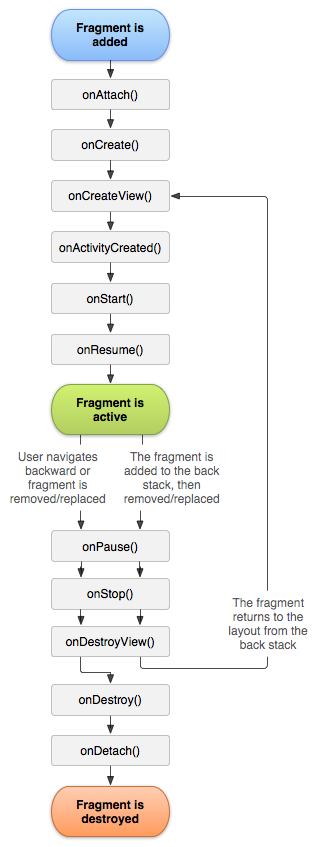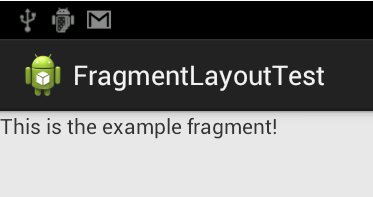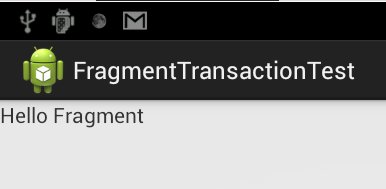Android App组件之Fragment说明和示例
1 Fragement介绍
Android从3.0开始引入Fragment,主要是为了支持更动态更灵活的界面设计。
Fragment是activity的界面中的一部分或一种行为。你可以把多个Fragment们组合到一个activity中来创建一个多面界面,你也可以在多个activity中重用一个Fragment。你可以把Fragment认为模块化的一段activity,它具有自己的生命周期,接收它自己的事件,并可以在activity运行时被添加或删除。
需要注意的是:Fragment不能独立存在,它必须嵌入到activity中,而且Fragment的生命周期直接受所在的activity的影响。例如:当activity暂停时,它拥有的所有的Fragment们都暂停了,当activity销毁时,它拥有的所有Fragment们都被销毁。
2 Fragment生命周期

3 Fragment实现方法
一般情况下,fragment把它的layout作为activitiy的loyout的一部分合并到activity中,有两种方法将一个fragment添加到activity中。
方法1:在activity的layout.xml文件中声明fragment
下面以一个应用实例来说明方法1。应用实例要求:创建一个activity,activity中包含Fragment。
layout文件fragment_layout_test.xml的代码如下:
<LinearLayout xmlns:android="http://schemas.android.com/apk/res/android" xmlns:tools="http://schemas.android.com/tools" android:layout_width="match_parent" android:layout_height="match_parent" android:orientation="vertical" > <fragment android:name="com.skywang.app.FragmentLayoutTest$ExampleFragment" android:id="@+id/list" android:layout_weight="1" android:layout_width="match_parent" android:layout_height="match_parent"/> </LinearLayout>
说明:
(01) 该layout仅仅只包含了一个fragment元素。
(02) fragment的属性 android:name="com.skywang.app.FragmentLayoutTest$ExampleFragment" 。意思是该layout包含一个fragment,这个fragment是定义在包名为"com.skywang.app"中类"FragmentLayoutTest""的内部类"ExampleFragment"中的。
FragmentLayoutTest.java的代码如下:
package com.skywang.app; import android.os.Bundle; import android.app.Activity; import android.view.View; import android.view.ViewGroup; import android.view.LayoutInflater; import android.widget.TextView; import android.app.Fragment; public class FragmentLayoutTest extends Activity { @Override protected void onCreate(Bundle savedInstanceState) { super.onCreate(savedInstanceState); // fragment_layout_test只包括ExampleFragment对象。 setContentView(R.layout.fragment_layout_test); } // 继承与Fragment public static class ExampleFragment extends Fragment { @Override public View onCreateView(LayoutInflater inflater, ViewGroup container, Bundle savedInstanceState) { return inflater.inflate(R.layout.example_fragment, container, false); } } }
说明:
(01) FragmentLayoutTest通过 setContentView(R.layout.fragment_layout_test) 来调用fragment_layout_test.xml来作为布局文件。
(02) 而上面的fragment_layout_test.xml布局文件仅仅值包括1个Fragment,该Fragment是通过ExampleFragment实现的。
(03) ExampleFragment继承于Fragment,在onCreateView()方法中通过 return inflater.inflate(R.layout.example_fragment, container, false); 来将example_fragment.xml作为其布局文件。
所以,相当于FragmentLayoutTest直接调用example_fragment.xml来显示。那为什么要费这么大劲,非要用到Fragment呢?原因是因为Fragment的可扩展性,它能作为一个独立的显示单元添加到activity中。本文仅仅只是为了说明fragment的layout实现方法;实际应用中,可能比这复杂很多。
layout文件example_fragment.xml的代码如下:
<LinearLayout xmlns:android="http://schemas.android.com/apk/res/android" xmlns:tools="http://schemas.android.com/tools" android:layout_width="match_parent" android:layout_height="match_parent" android:orientation="vertical" > <TextView android:text="@string/example_fragment" android:layout_width="wrap_content" android:layout_height="wrap_content"/> </LinearLayout>
说明:
(01) 采用LinearLayout线性布局,仅仅显示一个TextView。
点击下载:源代码
效果图:

方法2:在activity的layout.xml文件中声明包含
下面以一个应用实例来说明方法1。应用实例要求:创建一个activity,activity中包含一个Fragment,该Fragment采用动态加载的方式。
FragmentTransactionTest的代码:
package com.skywang.app; import android.os.Bundle; import android.view.LayoutInflater; import android.view.View; import android.view.ViewGroup; import android.app.Activity; import android.app.Fragment; import android.app.FragmentManager; import android.app.FragmentTransaction; public class FragmentTransactionTest extends Activity { @Override protected void onCreate(Bundle savedInstanceState) { super.onCreate(savedInstanceState); setContentView(R.layout.fragment_transaction_test); // 获取FragmentManager FragmentManager fragmentManager = getFragmentManager(); // 获取FragmentTransaction FragmentTransaction fragmentTransaction = fragmentManager.beginTransaction(); // 获取ExampleFragment ExampleFragment fragment = new ExampleFragment(); // 将fragment添加到容器about_fragment_container中 fragmentTransaction.add(R.id.about_fragment_container, fragment); fragmentTransaction.commit(); } // 继承与Fragment public static class ExampleFragment extends Fragment { @Override public View onCreateView(LayoutInflater inflater, ViewGroup container, Bundle savedInstanceState) { return inflater.inflate(R.layout.example_fragment, container, false); } } }
说明:
(01) 在onCreate()中该activit调用fragment_transaction_test作为其布局文件。
(02) 在onCreate()中,通过获取FragmentManager和FragmentTransaction,来将ExampleFragment对象添加到R.id.about_fragment_container中,about_fragment_container是一个Fragment。
(03) ExampleFragment的onCreateView()中,将example_fragment作为其布局文件。
fragment_transaction_test.xml的代码:
<LinearLayout xmlns:android="http://schemas.android.com/apk/res/android" android:layout_width="match_parent" android:layout_height="match_parent" android:orientation="vertical" > <FrameLayout android:id="@+id/about_fragment_container" android:layout_width="match_parent" android:layout_height="match_parent"/> </LinearLayout>
example_fragment.xml的代码:
<LinearLayout xmlns:android="http://schemas.android.com/apk/res/android" xmlns:tools="http://schemas.android.com/tools" android:layout_width="match_parent" android:layout_height="match_parent" android:orientation="vertical" > <TextView android:text="Hello Fragment" android:layout_width="wrap_content" android:layout_height="wrap_content"/> </LinearLayout>
点击下载:源代码
效果图:





